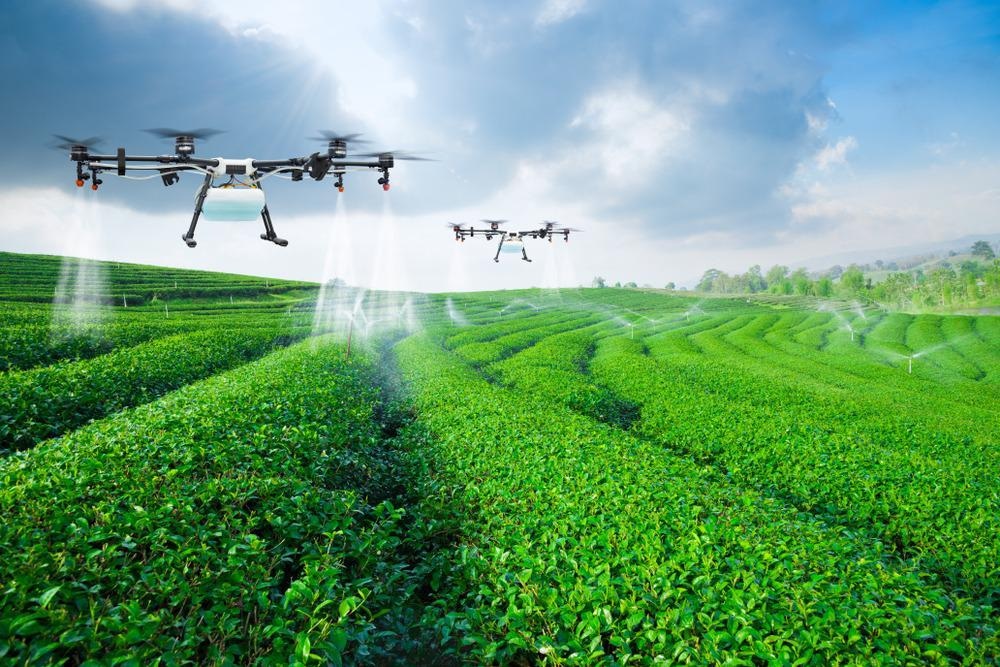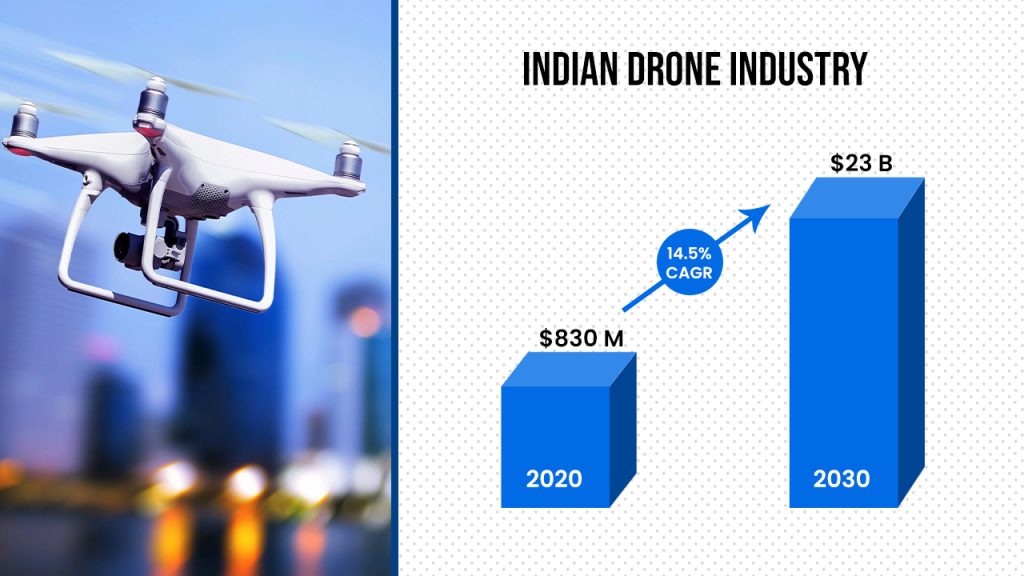Why Drone Startups A Budding Industry In India?
Today, several fertiliser businesses are aiming to use drones extensively as a means of delivering nutrients to farmers, adding that they are also closely watching prospective areas such as healthcare and e-commerce. Domestic demand is also driven by industries such as infrastructure, urban mapping, urban planning, and rural mapping.

Recall the bird-like unmanned aerial vehicle from the movie Uri The Surgical Strike. Yes, that’s the competency of the aerial robot. One more event, when terrorists attacked the Taj Mahal Palace in Mumbai in 2008, Ankit Mehta, an IIT-Bombay alumnus, thought that his little drone firm may have been valuable. There were reports that naval helicopters were trying to look into the third and fourth floors of the hotel, and the company felt that maybe their drones could have done the task, he adds.
Mr Mehta, who led the IIT’s innovation cell before graduating in 2005, created his first drone prototype in 2004 and founded a firm called ideaForge in 2007 to develop flying devices for a variety of applications. A year later, the Mumbai terror events motivated his team to develop drones for the defence services. They launched the first drone in 2009, which was transferred to the Maharashtra police in 2010. Since then, ideaForge has provided drones for surveillance and mapping to various government agencies and commercial businesses.

The business even went public to collect Rs 567 crore through an IPO. The IPO was supposed to finish on June 29 but was delayed by a day since markets were closed for Eid al-Adha. This money will cover working capital requirements and product development, among other things.
Ready for takeoff.
The trend of ideaForge’s growth illustrates the promise of India’s drone sector. It is considered a promising industry since these devices have applications in the military, e-commerce, logistics, healthcare, and other fields. In addition, India possesses the skill to design and manufacture unmanned aerial vehicles.
According to a 2022 EY-FICCI research, Making India the Drone Hub of the World, the domestic manufacturing potential for drones and parts in the defence, commercial, homeland security, and anti-unmanned aerial vehicle (UAV) industries is roughly Rs 1.8 lakh crore.
The government has stated that it intends to make India a worldwide drone centre by 2030. It expects the segment’s revenue to reach Rs 900 crore by 2024-25, up from Rs 60-80 crore in 2020-21. Is that a realistic goal? Experts think sure, as long as the government focuses on taking the necessary steps to support the ecosystem.
Since 2020, there has already been a major increase in drone production. According to Mr Arun Nagarajan, Partner-Technology Consulting, EY India, it has expanded at a CAGR of about 15% since then. Several government efforts have contributed to this expansion, like the Production Linked Incentive (PLI) Scheme, the Kisan Drone Scheme, and the Drone Shakti Programme.
Farmers may purchase these unmanned aerial vehicles to monitor crop health and apply fertiliser under the Kisan Drone Scheme, which offers incentives, subsidies, and financial support. Drone Shakti is an attempt to unite all parties, institutionalise, and build a framework. The government authorised the PLI Scheme for drones and drone parts in September 2021.
According to a government announcement, these, together with the liberalised Drone Rules, 2021, are “intended to catalyse super-normal expansion in the upcoming drone sector.” Over the next three years, it expects manufacturing to attract over Rs 5,000 crore investment and create over 10,000 direct employment. According to the statement, the drone services sector (logistics, traffic management, etc.) is predicted to rise to over Rs 30,000 crore over time and create over five lakh employment.
Signs of drone startup.
According to Mr Nagarjan, about 23 drone manufacturers have benefited from the PLI Scheme. As per the Ministry of Civil Aviation, the PLI Scheme recipients received Rs 30 crore in 2022-23. Agriculture and defence are the primary areas driving the expansion of drones in India today. The unmanned aerial vehicles in agriculture can potentially create five lakh additional direct jobs in India.

Today, several fertiliser businesses aim to use drones extensively to deliver nutrients to farmers, adding that they are also closely watching prospective areas such as healthcare and e-commerce. Domestic demand is also driven by industries such as infrastructure, urban mapping, urban planning, and rural mapping.
The government has provided more assistance. It will deploy a drone certification method created by the Quality Council of India in January 2022. The system examines prototypes to verify that they meet the basic safety and quality standards. This is being done to guarantee appropriate drone use across various industries, especially given the differences in specifications. These events also suggest that the drone market is on the rise. Nagarjan backs up this assertion by claiming that drone companies have increased by 35-40% in the previous two years.
According to Tracxn Technologies, 306 drone startups arose nationwide between 2011 and the end of 2022. This industry has also seen an increase in investment throughout the years. Drone startup financing increased by 390% in 2022, from $15.2 million in 2021 to $74.2 million in 2022. From $3.4 million in 2019 to $9.1 million in 2020, 165% and 67% rose in 2020 and 2021, respectively.
Creating an ecosystem.
An unmanned aerial vehicle ecosystem’s journey includes a mix of software and hardware. Considering the words of Nagarajan, this has resulted in an increase in the software ecosystem surrounding drone technology. However, analysts point out that there are several problems that must be solved for India to meet its objectives. One of the most significant is India’s absence of a component ecosystem. The majority of unmanned aerial vehicle parts must be imported.
According to Mr Prateek Srivastava, MD of Pune-based DroneAcharya, which provides services like maintenance and training, they must import parts such as flight controllers, batteries, electronic speed controllers, and motors. This is primarily due to India’s lack of a mature manufacturing facility for these critical unmanned aerial vehicle parts. In most circumstances, the need is imminent. As a result, rather than manufacturing their components and investing time in testing and trials, most manufacturers chose to purchase parts from the Asia-Pacific area, China, and Europe. Most of these parts have also been thoroughly tested and have the proven track record of performance.
India is believed to have purchased 22.5% of the world’s unmanned aerial vehicle imports between 1985 and 2014. The government prohibited the import of drones in 2022 unless they were for research and development, security, or defence purposes. This was done to promote domestic manufacture. Imports of unmanned aerial vehicle components are not prohibited. This effort may result in establishing an assembly line rather than a manufacturing ecosystem for drones in India. This contradicts the country’s goal of becoming a worldwide drone hub by 2030.

However, experts argue that this logic falls flat when an ecosystem must be rebuilt from the ground up since it requires a beginning point someplace. The unmanned aerial vehicle business is only getting started, especially after the pandemic. Around the same time, the government began supporting indigenous manufacturing, boosting the industry. There could not have been a local ecosystem in the country, says Mehta of ideaForge.
It’s being built up gradually. They are also collaborating with numerous manufacturers to indigenise many unmanned aerial vehicle technology subsystems. In reality, much of the purchase already comes from India. They’ve also invested in a firm that makes propellers for them.
So, there is a lot of investment happening in the local ecosystem, and it will shape up in the next several years in such a manner that a major part of what is happening or coming from outside will get done here. However, it will take some time.
The tale of Import vs. Indigenisation!
According to industry stakeholders, India should be prepared to face the reality that the government will not be able to eliminate imports and manufacture drones in India entirely. This is because some raw ingredients are just unavailable in the nation. Furthermore, Mehta believes that 100% local production is not always ideal. They also wish to market our products all over the world. As a result, subsystem components will always be shared throughout nations. The government is adopting a “measured approach” to constructing a component ecosystem. This has the potential to benefit a variety of industries.
Unmanned aerial vehicle components such as motors, propulsion systems, batteries, payloads, and communication modules are not just necessary for the drone industry. These components have a significant influence on sectors such as consumer durables, electric vehicles, autos, mobile phones, and so on. As a result, these components can improve production in various industries.
According to some analysts, the government expanded the PLI scheme to advanced chemistry to stimulate battery development. According to the EY analyst, while the programme would immediately benefit the electric car ecosystem, it would also aid in developing other categories, such as propulsion systems. As a result, the priority has been to lay the groundwork first.
A propulsion system, like a battery system, may be part of advanced chemistry by producing a force or thrust to propel any object, such as a rocket.
The need for Testing and certification.
While the emphasis is on developing drones, experts suggest we should not overlook the development of pilots for these UAVs. More facilities for training and certifying pilots should be built simultaneously. Currently, various IITs and NIITs are active in remote pilot training.
The Directorate General of Civil Aviation (DGCA) must certify all drone pilot training businesses. According to Mr Prem Kumar Vislawath, creator of Hyderabad-based Marut Drones, which manufactures UAVs for agricultural purposes, there is also an urgent need to enhance testing facilities. The country has no formal testing facility. For example, if one constructs an unmanned aerial vehicle capable of covering 100-200 kilometres, India has no specific testing facility.
He emphasises the scarcity of research funds in this field. This can stifle the development of innovative technologies with enormous commercial potential worldwide. There is also a scarcity of skills. There is a lot of aptitude for flying but not so much for engineering, software, and repair/maintenance. People that sell drones are unconcerned about repair and maintenance issues. If the country is to become a worldwide drone hub, he believes that after-sales assistance must be prioritised.

Conclusion.
Perhaps it is time for Indian enterprises to form technological collaborations and encourage intellectual transfer. Otherwise, the country’s current promise would vanish. That would be a huge missed opportunity, especially because unmanned aerial vehicles are a new technology used in civilian, commercial, and military settings. At this point of developing a massively dominating drone sector in India, the government should lead an ecosystem for training, testing, repair, and maintenance.




